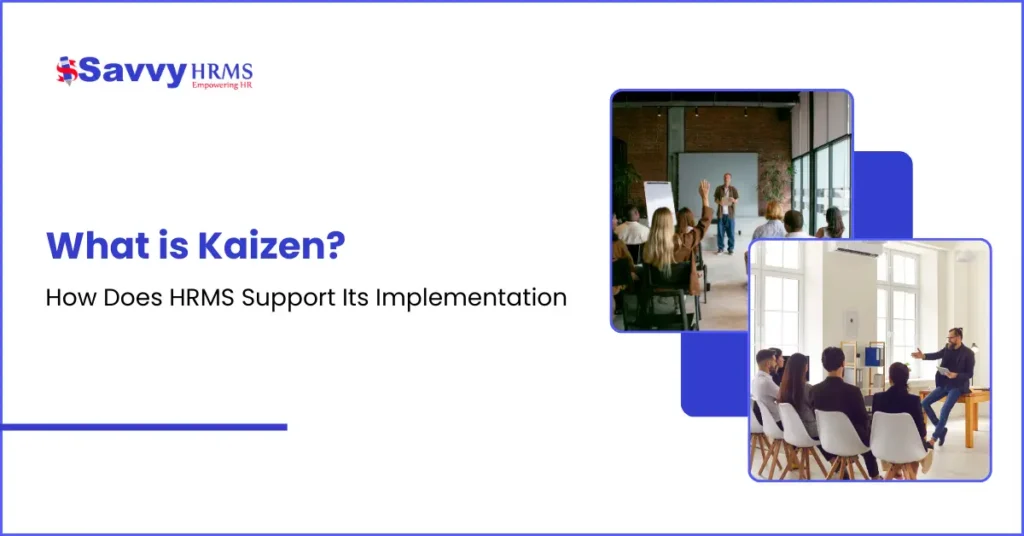Are SMEs really getting a complete view of employee performance, or are limited reviews slowing the growth of an organization?
Many small and mid-sized organizations depend on one-way performance reviews that miss team insights. This leaves the managers with incomplete decisions and employees without clear direction.
360-degree feedback changes that.
By collecting input from managers, colleagues, and teams it offers a full view of every employee’s strengths and improvement areas. SMEs benefit from clearer communication, stronger collaboration, and more engaged, motivated employees.
And while implementing 360-degree feedback may seem difficult, the right HRMS and a simple step-by-step process make it easy.
This blog covers why SMEs need 360-degree feedback, how it works, and how to implement it efficiently for better performance and growth.
What is 360-degree feedback?
A 360-degree feedback is an evaluation of performance that collects inputs from different sources – supervisors, peers, subordinates, and sometimes clients. This generates a comprehensive, rounded view of an employee’s skills, behaviour, and success.
Unlike the traditional review method, which only considers a manager’s and leaders’ opinions, this system focuses on a multi-level feedback system, promotes accuracy and fairness. It captures how employees communicate with the other team members and how others recognize their performance.
For SMEs, 360-degree feedback acts as a long-term development tool, helping identify potential leaders, improve communication, and enhance collaboration.
What should be included in a 360-degree feedback system?
A well-built 360-degree feedback system includes various elements that ensure the process remains systematic, objective, and actionable. Each part adds depth to the evaluation and ensures every view is captured effectively.
1. Self evaluation
Self-evaluation helps employees reflect on their performance and engage actively in their development. In SMEs, it promotes responsibility and partnership for growth.
Some of the key benefits include:
- It promotes honest self-reflection and self-awareness.
- Motivates setting realistic, achievable goals.
- Builds ownership and accountability for personal progress.
- Improves communication between employees and managers.
- Boosts continuous improvement and engagement in SMEs.
These points capture the essential benefits of self-evaluation in a concise manner suitable for your needs.
2. Peer review
Peer review offers colleagues a practical view of an employee’s teamwork, reliability, and problem-solving skills. It builds trust and improves fellowship among team members.
Some of the key benefits include:
- Provides unique insights into daily work habits and collaboration.
- Improves trust and strengthens team relationships.
- Offers practical feedback for improving group performance.
- Promotes open communication and mutual support.
- Helps identify strengths and areas for development unnoticed by managers.
This captures the core benefits of peer review in the workplace concisely and clearly.
3. Manager or Leader evaluation
Manager or leader evaluation provides a strategic perspective on employee performance and how well they align with organizational goals.
Some of the key benefits include:
- Focuses on alignment with organizational objectives and business results.
- Evaluates leadership abilities such as motivation, influence, and team management.
- Assesses consistency in meeting deadlines, quality of work, and goal execution.
- Uses data and behavioural insights to identify training and development needs.
- Helps determine preparedness for future leadership roles and promotions.
These points summarize how manager or leader evaluations contribute to both employee performance assessment and organizational growth.
4. Team members feedback
Team member feedback reveals how effectively leaders assign tasks, motivate, and communicate. Honest input helps managers identify blind spots, improve leadership, and address team issues.
Some of the key benefits include:
- Provides insights into leadership effectiveness from those directly impacted.
- Highlights communication strengths and inconsistencies within the team.
- Exposes blind spots in leadership style for targeted improvement.
- Encourages accountability and responsiveness to team dynamics.
- Boosts a culture of openness and trust between leaders and subordinates.
This summary reflects the key benefits of subordinate feedback for improving leadership and team performance.
5. Client feedback
Client feedback provides vital insights into professionalism, service quality, and communication for client-facing employees or managers. This feedback directly impacts reputation and growth, especially in SMEs.
Some of the key benefits include:
- Offers real-world insights into customer experience and satisfaction.
- Helps identify areas for service improvement and innovation.
- Builds trust and loyalty through responsive actions to feedback.
- Informs business decisions and strategies based on client needs.
- Improves reputation by establishing commitment to continuous improvement.
Client feedback is crucial for maintaining strong customer relationships and driving sustainable organizational growth in client-facing roles.
6. Expertise framework
An expertise framework in employee evaluation organizes feedback into clear, objective categories that reflect key organizational values and goals.
Some of the key benefits include:
- Provides structured and objective feedback categories.
- Aligns evaluations with organizational values and strategic goals.
- Covers important capacities such as communication and leadership.
- Facilitates consistent and fair assessment across employees.
- Supports targeted development aligned with company policies.
This framework helps maintain clarity, fairness, and actionable insights in performance evaluations.
7. Combined feedback report
A combined feedback report consolidates all individual feedback into a complete, confidential document highlighting strengths, areas of improvement, and repetitive patterns.
Some of the key benefits include:
- Integrates feedback from multiple sources into one merged report.
- Identifies consistent strengths and development needs across feedback.
- Reveals recurring themes for targeted interventions and improvements.
- Supports confidential, objective assessment to boost trust.
- Guides HR and employees in setting clear, actionable development plans.
Such combined reports enable strong performance insights and structured growth planning.
Why is 360-degree feedback important?
360-degree feedback plays an important role in developing an organization’s work culture, especially for SMEs struggling to build high-performing and motivated teams. It provides functional insights that go beyond level performance ratings.
360-degree feedback is important because it:
1. Support self-awareness
Employees may also have an absence of external support on how their behavior affects others. 360-degree feedback gives employees a reality check by combining different viewpoints, helping them to understand their impact and areas of improvement. Self-awareness is the base of personal and professional growth.
2. Improves collaboration and communication
When employees give and receive feedback openly, it inspires dialogue, teamwork, and respect. It minimizes the communication obstacles, helping team members to work more efficiently together. In SMEs where teamwork is important, open feedback channels result in higher collaboration and trust.
3. Identifies leadership potential
Through feedback from subordinates and peers, managers and leaders can easily identify employees which shows leadership skills like decision making, empathy, and leadership. This allows SMEs to raise internal talent and minimizes dependency on external hiring.
4. Encourages continuous learning
Rather than waiting for an annual promotion, a continuous 360-degree feedback system keeps the employees engaged in continuous self-improvement. Regular assessment creates a culture of learning and development that strengthens the organization’s productivity.
5. Improve employee engagement
When employees feel that their continuous are identified and valued from multiple views, their engagement also increases. Positive feedback gives clarity and direction, which directly enhances the motivation and growth in small businesses.
What are the steps of implementing a 360-degree feedback system?
Implementing a 360-degree feedback system for SMEs requires strategic planning and proper communication. When this process is completed in the right way, it enhances transparency and boosts employee engagement.
Steps for implementing 360-degree feedback include:
Step 1: Define clear objectives
Before beginning, decide whether your organization’s goal is leadership development, performance evaluation, or improving productivity. Clear objectives make sure that questions and contributors align with the planned purpose.
Step 2: Select participants thoughtfully
Select the individuals who have a good understanding with employees, managers, peers subordinates, or clients. Avoid including people’s minimum contact, as their feedback may have a negative impact.
Step 3: Select an effective HR tool
Selecting an automated platform such as Savvy HRMS ensures confidentiality, saves time, and terminates the manual data collection process. It also gives real-time insights and reports that simplify the explanation.
Step 4: Arrange behaviour-based questionnaires
Design questionnaires that mainly focus on noticeable behaviours and measurable competencies. For example, “Does this employee handle problems productively?” Instead of using unclear questions like “Is this employee good with other people?”
Step 5: Communicate transparently
Explain the objective and advantage of the feedback to the employees. Make it clear to the employees that the goal is development, not disapproval. Transparency builds trust and inspires honest participation.
Step 6: Analyze data and share insights
Outline the feedback results into understandable visuals and reports. Highlight both performance and improvement areas, focusing on positive results rather than issues.
Step 7: Create development and follow-up plans
Convert insights into actionable goals. Schedule training sessions, mentorship programs, or workshops to help employees improve. Regular check-ins keep progress on track and continue motivation.
Conclusion
A 360-degree Feedback system is not just an employee appraisal method; it’s a complete conversion tool for SMEs. Collecting feedback from everyone helps organizations to create more transparent, motivated, and accountable teams.
It helps employee to understand their strengths and weaknesses, and grow smoothly with the organization’s goals. For small businesses, it creates a positive feedback loop that drives collaboration and long-term success.
If your organization is ready to modernize its performance management, then Savvy HRMS is the best option. Its advanced 360-degree feedback system automates the whole process that ensures classification and delivers actionable insights, helping SMEs just like yours to unlock the genuine potential of their team members.



